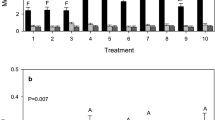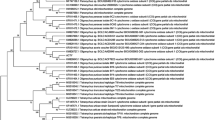Abstract
We review published and unpublished studies conducted in Israel with six acaropathogenic fungi, assayed in order to control the citrus rust mite, Phyllocoptruta oleivora (Ashmead) (CRM). Hirsutella thompsonii Fisher was introduced twice, killed 80–90% of the exposed mites, but due to its requirements for near-saturation humidities was deemed unsuitable for local outdoors conditions. Hirsutella kirchneri (Rostrup) Minter et al. and Hirsutella necatrix Minter et al. were also introduced and assayed against CRM and spider mites, but their efficacy was unsatisfactory. Three indigenous fungi found to be associated with mites, Meira geulakonigii, Meira argovae and Acaromyces ingoldii—all three recently described by Boekhout, Gerson, Scorzetti & Sztejnberg—were assayed against several mites. Meira geulakonigii killed 80–90% of several spider mites and of the CRM, and caused some mortality of Iphiseius degenerans (Berlese), one out of three phytoseiid predators assayed. Mortality was not due to parasitization; extracts from the media in which the fungi had developed caused considerable mite death, suggesting that it was a result of fungal toxins. Data from a field study indicated that spraying blastoconidia of M. geulakonigii on grapefruits infested by CRM significantly reduced pest-incurred damage from 23 to 13%. Applying qRT-PCR methodology indicated that M. geulakonigii was endophytic within sealed grapefruit flowers and in the flavedo of the fruits’ peel. Neither in the laboratory nor in the field was any evidence ever obtained that this fungus damaged the plants, leading us to hypothesize that M. geulakonigii serves as a “body guard” of grapefruits (and perhaps other plants as well). All three fungi suffered very little mortality after being exposed to various insecticides and acaricides that are in current local use (with the exception of sulfur). The ability of M. geulakonigii to reduce mite numbers without affecting the host plant, the minimal fungal effect on some predatory mites, its endophytic nature along with the apparent tolerance of M. geulakonigii to many insecticides and acaricides, suggest that this fungus could be suitable for integrated pest management (IPM) program.



Similar content being viewed by others
References
Abbott WS (1925) A method of computing the effectiveness of an insecticide. J Econ Entomol 18:265–267
Akello J, Dubois T, Gold CS et al (2007) Beauveria bassiana (Balsamo) Vuillemin as an endophyte in tissue culture banana (Musa spp). J Invertebr Pathol 96:34–42
Avis TJ, Caron SJ, Boekhout T et al (2001) Molecular and physiological analysis of the powdery mildew antagonist Pseudozyma flocculosa and related fungi. Phytopathology 91:249–254
Aghajanzadeh S, Prasad DT, Malik B (2007) Genetic diversity in Hirsutella thompsonii isolates based on random amplified polymorphic DNA analysis. Biocontrol 52:375–383
Bao J, Chen HK, Gonchen W (1990) Studies on Hirsutella necatrix Minter et al. and H. satumaensis newly occurring in Zhejiang Province. Acta Agric Univer Zhejiangensis 16:10–13
Boekhout T, Theelen B, Houbraken J et al (2003) Novel anamorphic mite-associated fungi belonging to the Ustilaginomycetes: Meira geulakonigii gen. nov., sp. nov., Meira argovae sp. nov. and Acaromyces ingoldii gen. nov., sp. nov. Int J Syst Evol Microbiol 53:1655–1664
Boucias DG, McCoy CW, Joslyn DJ (1982) Isozyme differentiation among 17 geographical isolates of Hirsutella thompsonii. J Invertebr Pathol 39:329–337
Cabrera RI, Dominguez D (1987) Hirsutella nodulosa e Hirsutella kirchneri, dos nuevos hongos patogenos del acaro del moho, Phyllocoptruta oleivora. Cien Tecno Agricol Protec Plant 10:139–142
Chandler D, Davidson G, Pell JK et al (2000) Fungal biocontrol of acari. Biocontrol Sci Technol 10:357–384
Chernin L, Gafni A, Mozes-Koch R et al (1997) Chitinolytic activity of the acaropathogenic fungi Hirsutella thompsonii and Hirsutella necatrix. Can J Microbiol 43:440–446
Dara SK (2007) Laboratory evaluation of fungus Hirsutella thompsonii (Deuteromycotina: Hyphomycetes) for the control of the cassava green mite, Mononychellus tanajoa (Acari: Tetranychidae). Bionotes 9:18–19
Diaz MP, Macias AF, Navarro SR, De la Torres M (2006) Mechanism of action of entomopathogenic fungi. Interciencia 31:856–860
Doron-Shloush S (1995) The biology of the fungus Hirsutella kirchneri and its influence on the citrus rust mite. MSc Thesis, Faculty of Agriculture, Hebrew University of Jerusalem, Jerusalem, Israel
Elliot SL, Sabelis MW, Janssen A, van der Geest LPS, Beerling EAM, Fransen J (2000) Can plants use entomopathogens as bodyguards? Ecol Lett 3:228–235
Fisher FE (1950) Two new species of Hirsutella Patouillard. Mycologia 42:190–297
Gafni A (1997) The biology of the acaropathogenic fungus Hirsutella necatrix. MSc Thesis, Faculty of Agriculture, Hebrew University of Jerusalem, Jerusalem, Israel
Gerson U, Kenneth R, Muttath TI (1979) Hirsutella thompsonii, a fungal pathogen of mites II. Host–pathogen interactions. Ann Appl Biol 91:29–40
Gerson U, Paz Z, Kushnir L, Sztejnberg A (2005) New fungi to control phytophagous mites and phytopathogenic fungi. IOBC/WPRS Bull 28(1):103–106
Gerson U, Smiley RL, Ochoa R (2003) Mites (Acari) for pest control. Blackwell Science, Oxford, UK
Hountondji FCC, Hanna R, Cherry AJ et al (2007) Scaling up tests on virulence of the cassava green mite fungal pathogen Neozygites tanajoae (Entomophthorales: Neozygitaceae) under controlled conditions: first observations at the population level. Exp Appl Acarol 41:153–168
Kanga LHB, James RR, Boucias DG (2002) Hirsutella thompsonii and Metarhizium anisopliae as potential microbial control agents of Varroa destructor, a honey bee parasit. J Invertebr Pathol 81:175–184
Kenneth R, Muttath TI, Gerson U (1979) Hirsutella thompsonii, a fungal pathogen of mites I. Biology of the fungus in vitro. Ann Appl Biol 91:21–28
Kumar PS, Anuroop CP (2004) A method to test the pathogenicity of fungi to Aceria guerreronsis with particular reference to Hirsutella thompsonii. Syst Appl Acarol 9:11–14
Lewis GC, Heard AJ, Brady BL, Minter DW (1981) Fungal parasitism of the eriophyid mite vector of ryegrass mosaic virus. In: Proc 1981 British Crop Prot Conf, pp 109–111
Lewis LC, Bruck DJ, Gunnarson RD, Bidne KG (2001) Assessment of plant pathogenicity of endophytic Beauveria bassiana in Bt transgenic and non-transgenic corn. Crop Sci 41:1395–1400
Miętkiewski R, Bałazy S, Tkaczuk C (2000) Mycopathogens of mites in Poland—a review. Biocontrol Sci Technol 10:459–465
Minter DW, Brady BL, Hall RA (1983) Five Hyphomycetes isolated from eriophyid mites. Trans Br Mycol Soc 81:455–471
Mozes-Koch R, Edelbaum O, Livneh O et al (1995) Identification of Hirsutella species, isolates within a species and intraspecific heterokaryons by random amplified polymorphic DNA. Z Pflanzenkrankh Pflanzenschutz 102:284–290
Odongo B, Odindo MO, Brownbridge M, Kumar R (1998) Comparative biological efficacy of Hirsutella thompsonii and Neoseiulus teke for cassava mite (Mononychellus tanajoa) suppression. Biocontrol Sci Tech 8:345–355
Palevsky E, Argov Y, Ben-David T, Gerson U (2003) Identification and evaluation of potential predators of the citrus rust mite, Phyllocoptruta oleivora, in Israel. Syst Appl Acarol 8:39–48
Paz Z (2007) Biological control of phytophagous mites by the fungi Meira geulakonigii, Meira argovae and Acaromyces ingoldii: host range and mechanism. PhD Thesis, Hebrew University of Jerusalem, Jerusalem, Israel
Paz Z, Gerson U, Sztejnberg A (2007a) Assaying three new fungi against citrus mites in the laboratory, and a field trial. Biocontrol 52:855–862
Paz Z, Burdman S, Gerson U, Sztejnberg A (2007b) Antagonistic effects of the endophytic fungus Meira geulakonigii on the citrus rust mite Phyllocoptruta oleivora. J Appl Microbiol 103:2570–2579
Rombach MC, Roberts DW, Shepard BM (1986) Hirsutella thompsonii Fisher infecting phytophgous mites in the Philippines. Philipp Entomol 6:620–622
Rombach MC, Gillespie AT (1988) Entomogenous Hyphomycetes for insect and mite control on greenhouse crops. Biocontrol News Inf 9:7–18
Roy HE, Pell JK (2000) Interaction between entomopathogenic fungi and other natural enemies: Implication for biological control. Biocontrol Sci Technol 10:737–752
Stone JK, Bacon CW, White JF Jr (2000) An overview of endophytic microbes: endophytism defined. In: Bacon CW, White JF Jr (eds) Microbial endophytes. Marcel Dekker, NY, pp 3–29
Sztejnberg A, Doron-Shloush S, Gerson U (1997) The biology of the acaropathogenic fungus Hirsutella kirchneri. Biocontrol Sci Technol 7:577–590
Sztejnberg A, Paz Z, Boekhout T et al (2004) A new fungus with dual biocontrol capabilities: reducing the numbers of phytophagous mites and powdery mildew disease damage. Crop Prot 23:1125–1129
Torgeson DC (1967) Determination and measurement of fungitoxicity. In: Torgeson DC (ed) Fungicides an advanced treatise, vol 1. Academic Press, New York, pp 93–123
van der Geest LPS, Elliot SL, Breeuwer JAJ, Beerling EAM (2000) Diseases of mites. Exp Appl Acarol 24:497–560
Wekesa VW, Knapp M, Maniania NK, Boga HI (2006) Effects of Beauveria bassiana and Metarhizium anisopliae on mortality, fecundity and egg fertility of Tetranychus evansi. J Appl Entomol 130:155–159
Author information
Authors and Affiliations
Corresponding author
Rights and permissions
About this article
Cite this article
Gerson, U., Gafni, A., Paz, Z. et al. A tale of three acaropathogenic fungi in Israel: Hirsutella, Meira and Acaromyces . Exp Appl Acarol 46, 183–194 (2008). https://doi.org/10.1007/s10493-008-9202-6
Received:
Accepted:
Published:
Issue Date:
DOI: https://doi.org/10.1007/s10493-008-9202-6




